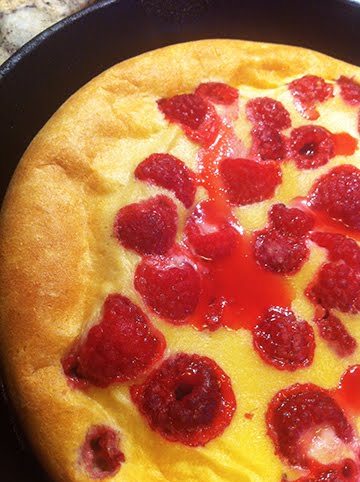
Eggs benedict isn't just for fancy restaurants. You can make them at home. This classic dish is perfect for spring. Farm fresh eggs can be found at farmers markets and roadside stands.

Asparagus are sweet and green and bursting with flavor. Egg yolks and asparagus are a great pairing. This is a truly decadent dish, especially since it has Hollandaise sauce…all those egg yolks and that melted butter makes a heavenly, rich sauce! If you can find Meyer lemons, they work beautifully in this sauce. If not, use a fresh lemon in any variety available to you. Don’t use bottled or frozen juice…the fresh juice helps the egg yolks accept the butter in the sauce and adds a sprightly flavor, too. This would be impressive for a springtime brunch with a select, small guest list.
I think I’ve only had Eggs Benedict about 5 times in my life, and never with asparagus. I’ve wanted to try making it for a long time but was put off by all of the parts seeming so complicated and not sure that I could pull it off. Well, dear readers, I did it! I'm going to make this my first entry in the High Five Un-group hosted by the lovely Lynn at Cookie Baker Lynn blog. If you want to participate, check it out
here.

I made this for Sweetie for breakfast on a morning when we were not in a hurry. He enjoyed his coffee while I put together the various parts. I had made the English muffins ahead and had them ready to toast. This recipe did create quite a few dishes to wash up, and it does take some concentration to get all of the parts ready at the same time, but none of it is difficult.
The sauce is ready in minutes – I read the classic way to do it and blessed the invention of the food processor and blender...so much faster and fairly foolproof unlike the old way. The eggs take less than one minute to put into cups and four minutes to poach. The asparagus only take three or four minutes total. I suspect that toasting the muffins takes the longest.
TIMING is EverythingPlan the order in which you will do the different parts and everything will turn out fine. Read through the various recipes. You may want to make your own list. This is the order I used:
Split the muffins and set by toaster.

Fill the pot to 2 ½ inches and bring to boil, add the vinegar, then set to simmer
Prepare the asparagus for steaming
Juice the Meyer lemon and strain the juice
Separate the egg yolks for the hollandaise and put into the food processor
Crack an egg into four custard cups
Set out the plates, the pitcher for the sauce, and two bowls for hot water
Melt the butter for the hollandaise
Toast the first English muffin
While muffin is toasting, begin the hollandaise, through adding the hot melted butter…leave it running
Slip the eggs into the simmering water. Set timer
Pour the finished sauce into pitcher and fill bowl with enough hot water to come half way up pitcher
Put second English muffin in toaster
Steam the asparagus
Put hot water into second bowl
When timer goes off, use slotted spoon to remove poached eggs to bowl of hot water
Remove asparagus from microwave
Plate toasted muffins, add asparagus
Use slotted spoon to removed rinsed eggs from hot water, let drip, put over asparagus and muffins
Pour on hollandaise

Grind on pepper
(Take photos if you are a blogger) and prepare other plate the same way
Serve!

If you like you can do the following the day before:- Juice the lemon, strain the juice, store in a small container in fridge. Let come to room temperature.
- Split the muffins. Store in airtight container
- Prepare the asparagus but don’ t steam. Store in fridge. If still cold when steamed, you may have to steam a little longer
- Separate the eggs for the sauce. Reserve the whites for another use. Store, covered, in the fridge. Bring to room temperature to use for the sauce
- Crack an egg into individual cups or containers. Store, covered, in the fridge. Bring to room temperature before poaching
Here are the parts of the recipe:
Eggs Benedicts with Asparagus and Meyer Lemon Hollandaise SauceThe AsparagusFor each serving: 3 – 4 spears of very fresh asparagus, ends snapped off. Steam your favorite way, and keep warm until ready to assemble.( I put mine on a microwave safe plate, added a teaspoon of water, covered and microwaved two minutes on high power. I did this after the eggs had started poaching, while the second English muffin was toasting, and after the hollandaise sauce was done and keeping warm.)
The English MuffinsPrepare English muffins using your favorite recipe, or purchase some.

Split with a fork to keep the craggy interior to trap the egg yolks and hollandaise. Toast while the hollandaise is being prepared and eggs are poaching. Keep warm until ready to assemble the dish. (I covered mine with a folded dishtowel.) Plan on an English muffin per person, plus a few extras for swabbing up the copious egg yolk.
The Blender Hollandaise (I used a food processor and it worked fine)
from All Recipes:http://allrecipes.com/Recipe/Blender-Hollandaise-Sauce/Detail.aspx
Ingredients – enough for 3-4 people
3 egg yolks
1 tablespoon lemon juice
1/2 cup butter
Directions
In the container of a blender (or food processor), combine the egg yolks, and lemon juice. Cover, and blend for about 5 seconds.
Place the butter in a glass measuring cup. Heat butter in the microwave for about 1 minute, or until completely melted and hot. Set the blender on high speed, and pour the butter into the egg yolk mixture in a thin stream. It should thicken almost immediately. (If doing in a food processor, keep it running for another minute or two while you get the eggs into the poaching water. The extra time helps with the thickening process). Keep the sauce warm until serving by placing the blender container in a pan of hot tap water. (If using a food processor, pour the hollandaise into a heat proof small pitcher and put that into a pan or bowl of hot water.)
 The Poached Eggs
The Poached Eggs – enough for 2-3 people
You will need:
4 to 6 fresh, cold, eggs
2 quarts boiling water in a saucepan about 8 inches in diameter
(depth of water should be about 2 1/2 inches)
1/3 cup, white vinegar (2 1/2 tablespoons per quart)
Equipment: a perforated spoon; a kitchen timer; a bowl of very warm water (120 degrees).
Preparing the poaching water: Pour the vinegar into the boiling water, and reduce the heat so that the water is just at the simmer – quietly bubbling. Vinegar quickly coagulates the white when the naked egg enters the water, and this in turn helps preserve its oval shape – again, if the egg is reasonably fresh. If you can find fresh eggs from the farm, do use them. You really taste the eggs in this dish.
Getting the eggs into the water: Being a wuss about boiling water, I took the low road and cracked an egg each into four custard cups. Once I was ready, with the English muffins toasting, the asparagus ready to steam, and the hollandaise sauce almost finished in the food processor, I made sure that the water was simmering, then put the lip of the custard cup as close to the top of the water as possible and gently let the egg slide with one movement into the simmering water. Set timer for 4 minutes. Rapidly continued with the 3 other eggs, adding them clockwise around edge of pan. Because I didn’t do the version where you prick the end of the egg and give it a quick bath in the shell in boiling water, bits of the white did trail away from the poaching eggs, but it was fine in the end.
Finishing the eggs: Regulate the heat so that the poaching water remains at hardly a bubble, and when 4 minutes are up, carefully remove first egg with a perforated spoon and slide it into the bowl of very warm water, to wash off the vinegar. Estimating how much time you took for each additional egg - it will be 15 seconds at most when you are used to the movements - remove the other eggs in turn.
Keeping eggs warm after cooking them: The eggs will keep warm as long as the water remains warm, and they cannot overcook if water is not hotter than 120 degrees; if your wait is a bit long, pour a little boiling water into the bowl from time to time. (I also added a bit of boiling water to the bowl holding the hollandaise pitcher, just to make sure it stayed warm.) If you will be serving more than three people, I would have another pan of water to poach additional eggs, but keeping the timing right is tricky for 4-6 eggs and more difficult with more eggs and toasted English muffins to keep warm. You could serve one muffin half, one egg and some asparagus alongside to double the number served, but be prepared for requests for seconds!
 Putting It All Together
Putting It All TogetherHave the table set and plates ready. Once the eggs are in the warm water to rinse off the vinegar, put an English muffin, toasted, both top and bottom if you are having two eggs per person, onto each plate. Top each plated muffin set with 3 spears of the steamed asparagus, laid crosswise over the muffin pieces, top each muffin piece with a poached egg (the classic method is to dry the egg in a clean towel…I just used the slotted spoon and let the water drip for a couple of seconds) placing over any part of the asparagus that is on the muffin, and immediately pour on some hollandaise sauce over all. If desired, grind some fresh pepper on top of each egg. Serve at once while everything is hot. Repeat for each plate of Eggs Benedict. Enjoy the compliments of your family and/or guests.
 Seasonal treats of springtime include the wonderful, soft, spicy, fruity hot cross buns. They are fairly quick and easy to make and delicious to eat. I remember eating buns like these when I was a child. Easter was a special time for children when I was growning up. We often had something new to wear to church and the church would have pots of Easter lilies at the altar. After breakfast we were anxious to check out our Easter baskets, all lined up in a row in the living room, filled with jelly beans and marshmallow eggs, yellow and pink marshmallow chicks, and chocolate bunnies. The eggs we had colored the day before became the stars of Easter egg hunts,
Seasonal treats of springtime include the wonderful, soft, spicy, fruity hot cross buns. They are fairly quick and easy to make and delicious to eat. I remember eating buns like these when I was a child. Easter was a special time for children when I was growning up. We often had something new to wear to church and the church would have pots of Easter lilies at the altar. After breakfast we were anxious to check out our Easter baskets, all lined up in a row in the living room, filled with jelly beans and marshmallow eggs, yellow and pink marshmallow chicks, and chocolate bunnies. The eggs we had colored the day before became the stars of Easter egg hunts, and my dad would take home movies of us finding the eggs on automobile bumpers and in clumps of grass, holding up the bright egg to the camera with a smile. It's no wonder that I still enjoy making colored eggs and special treats like these buns.
and my dad would take home movies of us finding the eggs on automobile bumpers and in clumps of grass, holding up the bright egg to the camera with a smile. It's no wonder that I still enjoy making colored eggs and special treats like these buns. This is my entry to Tangerine's Kitchen for Bread Baking Day #28 - Bread Buns, plus I'm sending it over to Susan of Wild Yeast's Yeastspotting weekly event. Many thanks go to Susan for this weekly compilation of wonderful yeast based recipes!
This is my entry to Tangerine's Kitchen for Bread Baking Day #28 - Bread Buns, plus I'm sending it over to Susan of Wild Yeast's Yeastspotting weekly event. Many thanks go to Susan for this weekly compilation of wonderful yeast based recipes!


















































